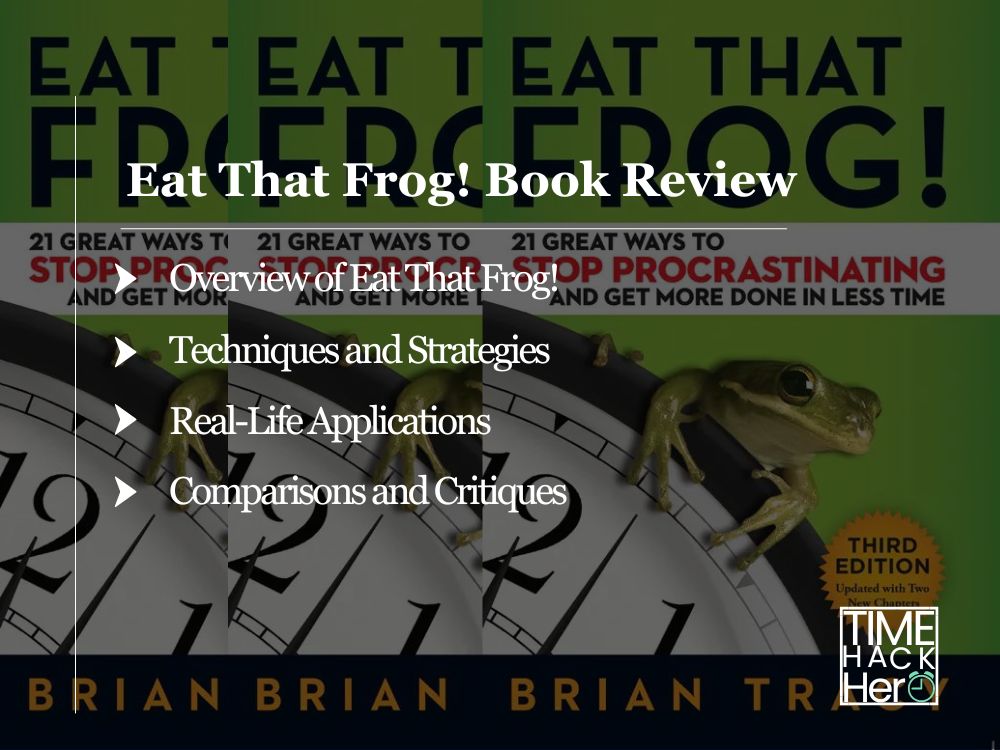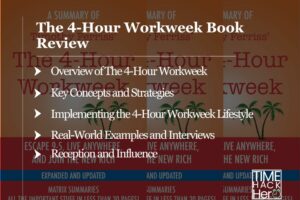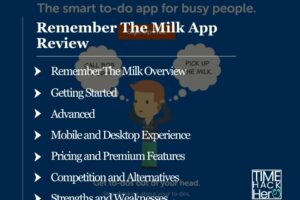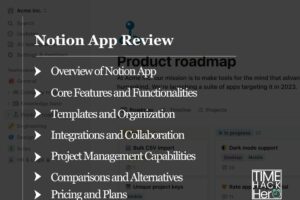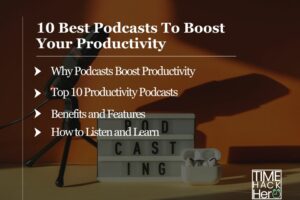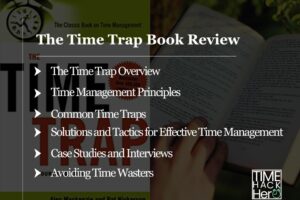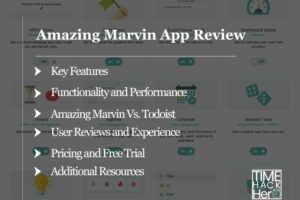Eat That Frog! by Brian Tracy is a highly regarded self-help book that focuses on time management and productivity. First published in 2001, the book has become a staple in productivity circles, offering readers insights and actionable steps on how to stop procrastinating and get more done in less time.
The book’s title and main metaphor, “eat that frog,” emphasizes the importance of prioritizing one’s tasks, tackling the most significant and unpleasant tasks first. By “eating the frog” as the first thing on your list, you set yourself up for a productive day, knowing that the hardest part is already behind you.
Tracy outlines 21 strategies for overcoming procrastination, each accompanied by actionable tasks aimed at helping readers improve their productivity. These strategies are suitable for various individuals, regardless of their profession or personal life. In the following article, we will delve deeper into the book’s main concepts, insights, and benefits for anyone looking to enhance their time management skills and overall productivity.
Table of Contents
Overview of Eat That Frog!
Brian Tracy
Brian Tracy, a renowned motivational speaker and author, wrote the book “Eat That Frog! 21 Great Ways to Stop Procrastinating and Get More Done in Less Time.” It was first published in 2001 and has since become a popular resource in productivity and time management circles.
Key Concepts
“Eat That Frog!” presents 21 powerful principles on personal effectiveness. These practical tips are designed to help readers overcome procrastination and improve productivity.
- Set the Table: Define your goals clearly and understand what needs to be accomplished.
- Plan Each Day in Advance: Organize your tasks daily and prioritize them to make the most of your time.
- Apply the 80/20 Rule: Identify the 20% of tasks that contribute 80% of your desired results and focus on them.
- Consider the Consequences: Consider immediate and long-term effects of tasks, and prioritize those with significant impacts on your goals.
- Practice Creative Procrastination: Intentionally delay low-value tasks and focus on high-value ones.
- Use the ABCDE Method: Assign priorities to tasks (A: most important, B: should do, C: nice to do, D: delegate, E: eliminate).
- Focus on Key Result Areas: Determine your critical results areas, and allocate time to them to enhance your performance.
- Obey the Law of Forced Efficiency: Improve your ability to deliver high-quality results in a limited amount of time.
- Prepare Thoroughly Before You Begin: Gather the necessary tools and resources to complete a task before starting.
- Take It One Oil Barrel at a Time: Break tasks into smaller steps, and focus on completing each step one at a time.
The central concept of “Eat That Frog!” is that your “frog” is your biggest and most important task. To overcome procrastination, you should complete this task first. If you have multiple important tasks or “frogs” to accomplish, you should start with the most challenging one. The book helps readers develop an action-oriented mindset to prioritize and accomplish their goals effectively.
Techniques and Strategies
ABCDE Method
The ABCDE method is a technique to help prioritize tasks, beat procrastination, and improve productivity. Tasks are assigned a letter based on their importance, helping to determine which tasks should be done first. A represents high-value activities, B represents tasks with minor consequences, and so on. By focusing on A tasks, you maximize results and efficiency.
Slice and Dice the Task
Slice and Dice the Task is a technique for breaking down larger tasks into smaller, actionable steps. By dividing a major task into smaller tasks, it becomes more manageable and less intimidating, making it easier to start and complete.
Law of Three
The Law of Three emphasizes focusing on the top three key result areas of your life: work, personal relationships, and happiness. By identifying and prioritizing these areas, this method helps balance work and personal life, leading to success and fulfillment.
Focus on Key Result Areas
Focusing on Key Result Areas (KRAs) involves identifying and concentrating on tasks that directly contribute to your goals. This technique enables you to work more efficiently by directing your efforts toward high-value activities that produce the most significant results.
Prepare Thoroughly
Preparing thoroughly involves taking time to plan, gather necessary resources, and establish a clear understanding of the task at hand before starting. This technique helps to minimize obstacles, reduce stress, and increase your ability to perform and finish the task efficiently.
Leverage Your Special Talents
Leveraging your special talents means recognizing and utilizing your unique skills to excel in your work. By focusing on tasks that align with your strengths, you can accomplish more with less effort and differentiate yourself from others in your field.
Maximize Your Personal Power
Maximizing your personal power involves managing your energy levels, maintaining a healthy lifestyle, and optimizing the use of your time. By doing so, you increase your capacity to perform at your best, make better decisions, and achieve success.
Motivate Yourself into Action
Motivating yourself into action is about creating a sense of urgency and determination to complete tasks. This technique involves setting short-term goals, visualizing the benefits and consequences of completing (or not completing) tasks, and rewarding yourself for progress.
Create Large Chunks of Time
Creating large chunks of time involves scheduling uninterrupted blocks of time dedicated to completing your most important tasks. This technique helps increase focus and efficiency and is particularly useful when tackling challenging tasks requiring deep concentration.
Develop a Sense of Urgency
Developing a sense of urgency involves recognizing the importance of completing tasks promptly. This technique helps address the 80/20 rule (Pareto Principle) by concentrating efforts on the 20% of tasks that yield 80% of the results. A heightened sense of urgency increases productivity by minimizing procrastination and driving you to take action.
Single Handle Every Task
Single handling every task means fully dedicating yourself to one task at a time until it is completed. This technique reduces distractions and encourages focus on the task at hand, leading to more efficient and high-quality work.
Real-Life Applications
Time Management
In “Eat That Frog!”, the author emphasizes the importance of time management by introducing the 80/20 rule. This rule suggests that 80% of your productivity comes from 20% of your efforts. By identifying and focusing on your most important tasks, you can improve your time management skills, which will subsequently lead to increased productivity.
Goal Setting
The book highlights the significance of setting clear and actionable goals. Brian Tracy encourages readers to write down their goals and break them into smaller, manageable tasks. By doing this, you can create a structured plan for success and ensure that you’re working towards meaningful objectives.
Overcoming Procrastination
Procrastination is a major barrier to productivity. “Eat That Frog!” teaches readers how to overcome procrastination by tackling the most challenging tasks first. By starting your day with your most important task, you’re less likely to procrastinate and more likely to maintain productivity throughout the day.
Career and Professional Growth
The principles in “Eat That Frog!” can be applied to various aspects of your career, from improving your time management skills at work to developing important key result areas. By learning to prioritize tasks effectively, you can focus on areas that will drive success and professional growth for you and your organization.
Personal Life
While “Eat That Frog!” primarily targets professional productivity, its strategies can be applied to your personal life as well. Time management, goal setting, and overcoming procrastination are all crucial skills for managing personal commitments and maintaining a balanced lifestyle. For example, implementing creative procrastination allows you to prioritize tasks and intentionally delay less significant tasks, which can lead to a more balanced and fulfilling personal life.
Comparisons and Critiques
Similar Books and Theories
“Eat That Frog!” by Brian Tracy focuses on 21 ways to overcome procrastination and improve productivity. The book shares some similarities with other time management and self-help works, such as:
- “Getting Things Done” by David Allen: Both books emphasize the importance of prioritizing tasks and organizing one’s workload to increase efficiency.
- “The 7 Habits of Highly Effective People” by Stephen Covey: Although the focus of Covey’s book is more comprehensive, both books discuss the concept of scheduling important tasks first.
- “The Pomodoro Technique” by Francesco Cirillo: Both techniques share the goal of breaking down tasks into manageable chunks and taking regular breaks to maintain focus and productivity.
Contrasting Approaches
While “Eat That Frog!” is a practical, action-oriented guide for overcoming procrastination, other methods take different approaches to improving productivity:
- “Deep Work” by Cal Newport: Rather than focusing on task management, Newport emphasizes the value of undistracted, focused work sessions to create high-quality output.
- “The Power of Habit” by Charles Duhigg: Duhigg explores the science behind habit formation and suggests that changing one’s habits is the key to long-term productivity improvement.
Reception and Reviews
Since its publication in 2001, “Eat That Frog!” has received mostly positive reviews and has been widely recommended in productivity circles. Many readers appreciate its simple, easy-to-follow guidelines and actionable advice. However, some criticisms have been noted:
- Lack of originality: Critics argue that some of the concepts and techniques in “Eat That Frog!” can be found in other time management and self-help books.
- Oversimplification: Some readers feel that the book’s straightforward approach might not address the complexity of productivity challenges faced by certain individuals.
Despite these criticisms, “Eat That Frog!” remains a popular and valuable resource for those seeking to overcome procrastination and get more done in less time.

